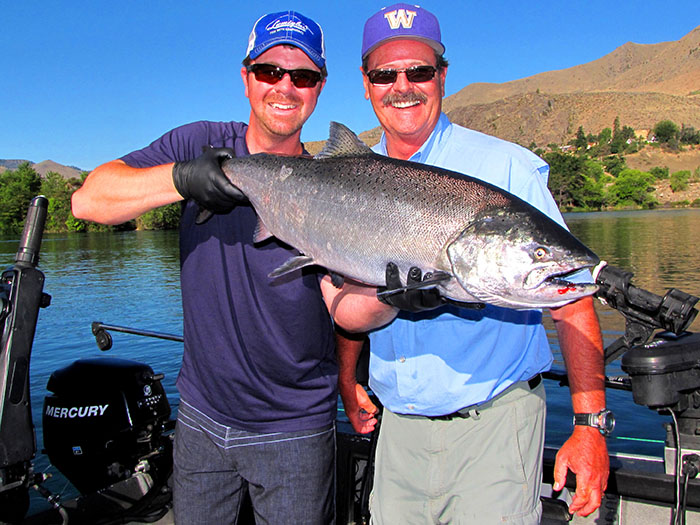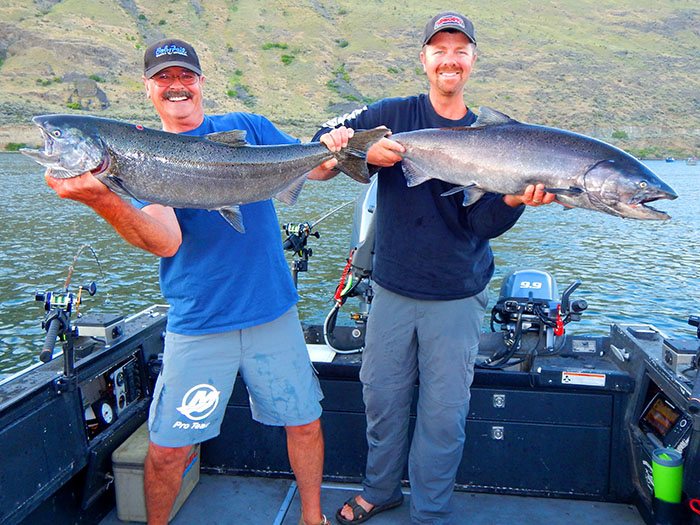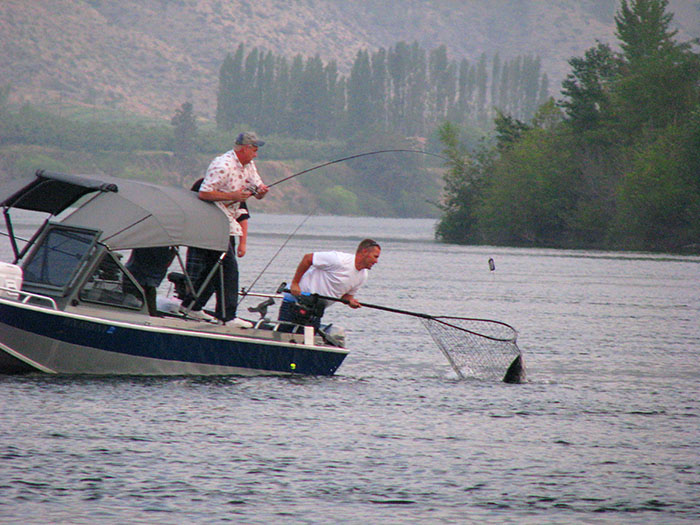Look to the Upper Columbia For Summer Salmon Action Leave a reply

Shane Magnuson helps me show off a dandy king I landed fishing with him at Chelan Falls. (Dave Graybill Photo)
By Dave Graybill
No other season attracts more anglers to the upper Columbia River than when the summer-run and sockeye salmon seasons open on July 1st every year. While most salmon seasons are announced by Emergency Regulations on the upper Columbia, the summer-run salmon earned a permanent listing in the Washington Sport Fishing Rules pamphlet over a decade ago. This is the time of the year anglers can count on visiting Central Washington and expect to find excellent numbers of Chinook salmon to fill their coolers.
The first place that salmon anglers focus their attention is above Priest Rapids Dam. There are a couple of spots that some anglers will troll in the early season, such as right above the dam and off the mouth of Crab Creek near Schwana. The biggest crowd will be found right below Wanapum Dam. Here boats circle around in what is known as the “Toilet Bowl” where hordes of early-arriving kings stack up before entering the fish ladder and moving on up river. Anglers also encounter returning sockeye salmon, and they can be seen surfacing in waves along the face of the rip rap bank. It is not unusual for sockeye to be taken on gear intended for kings.
Most of the boats will be trolling Super Baits behind flashers below Wanapum. Some will fish lighter sockeye gear on a couple of rods after the morning bite has slowed. The fishing will be good here starting July 1st and for many weeks, until the bulk of the early-returning Chinook and sockeye have passed on to the upper river. There is a much-improved staging and parking area right below Wanapum. Still there can be a very long line of boats waiting to launch before daylight on opening day. There is also a very good launch on the opposite shore, on Huntzinger Road below the dam. When running up to Wanapum, take special care and watch for shallow, rocky reefs. There is a small area on the west side of the river where boats will troll for salmon just above Wanapum Dam, and a few will even fish the east side of the river below the Vantage Bridge. This is near the junction for the road to Mattawa. There is a launch in the town of Vantage, and at the State Park on the west side of the river below the Vantage Bridge.
The next major fishing locations for summer-runs and sockeye are on the Columbia at Wenatchee. There are good areas to find Chinook scattered “between the bridges” on either side of the river here. There is excellent access to the river via improved launches. One is at the base of Orondo Street, and is free of charge. Another is at Confluence State Park, where a Discovery Pass and launch fee is required. Walla Walla Point, below the mouth of the Wenatchee River, is one of the best-known fishing spots for Chinook. Sockeye and Chinook are also taken below Rocky Reach Dam. When the fish are really pouring through this area and over Rocky Reach Dam there are many kings and sockeye taken above Rocky Reach. Anglers launch at Lincoln Rock State Park (Discovery Pass and launch fee required), which is on the Douglas County or east side of the river, and run over to troll the west shore along the highway to Entiat and Chelan. In recent years the fishing for Chinook has been very good for summer-run salmon off the mouth of the Entiat River.

I struggle to hold up one of the two kings that Shane Magnuson and I landed at Chelan Falls. (Dave Graybill Photo)
Rapidly becoming a favorite of salmon anglers, particularly in the early season, is Chelan Falls. Located just below the Beebe Bridge, with PUD parks with free launches on both sides of the river, this spot is loaded with kings. Success has been very good here in recent years, and there is lots of good water for trolling Super Baits behind flashers on downriggers or with lead balls. One of the reasons that Chelan Falls has become popular is the high ratio of hatchery origin fish in catches. This is due to the net pen releases of smolt in the Chelan River channel. Another benefit of fishing this area is that it is about a 15- to 20-minute run up to Wells Dam. When sockeye are returning in good numbers, the fishing is very good, particularly in the big eddy on the north side of the river right below the dam.
Wells Dam is an excellent place to fish for kings. Anglers will troll off the bar below the dam and the big eddy on the opposite side of the river also produces very good catches of salmon. There is an excellent launch accessed from the highway that leads to Pateros. Some sockeye are taken above the dam and fishing for Chinook is very good when big numbers of fish are crossing over Wells Dam.
The crown jewel of salmon fishing on the upper river is the Brewster Pool, where the Okanogan River enters the Columbia. The Okanogan is a shallow, slow moving river and in the summer it gets very warm. When it enters the Columbia it creates a “thermal barrier” that keeps the salmon from moving up into the Okanogan. Kings continue to move up into the Brewster Pool from the lower river and stack up in the colder water of the Pool. Thousands of fish are milling around in this area, and are easy prey to anglers. Sockeye also prefer this colder water and join the kings in their wait for temperatures to drop in the Okanogan before they make their way up the river and on to their spawning grounds in British Columbia.

I love this shot of an angler scooping a nice king from the water at Chelan Falls. (Dave Graybill Photo)
This thermal barrier is one of the reasons that the Brewster Salmon Derby, which takes place the first weekend in August every year, is so popular. The success rate for anglers that participate in this derby is the best for salmon derbies anywhere. To learn all about the derby, visit www.brewstersalmonderby.com.
Something that salmon anglers should know that makes this particular season special on the upper Columbia is that it is the first return of four-year old Chinook salmon that were released from the Colville Tribal Fish Hatchery at Bridgeport. These will add to the numbers of fish available to anglers in the Brewster Pool and on up the river where they meet their final barrier on the Columbia River, Chief Joseph Dam. Summer-run Chinook season is a selective fishery, with barbless hooks required and wild fish must be released. Not only will the fish returning to the Colville Hatchery add to the numbers of fish in the Brewster Pool, they are all adipose fin clipped, keepers. The opportunity for catching a king and keeping it is significantly higher this year in the Brewster Pool and the river up to Chief Joseph Dam. There is the potential for a rule change affecting the Brewster Pool that may make fishing here even more attractive to anglers. Watch the department’s web site for this change.
The techniques that are used throughout the Columbia River, in all of the locations I have mentioned don’t vary much. There are some that stick to the tried and true plug cut herring, and those that really know how to properly cut and prepare herring have success. By far the most popular method being used at this time for catching kings is with the Super Bait. Some use the old, banana-shaped style and more and more anglers are using the newer plug cut version. Super Baits come in wide variety of colors, but some of the more popular are the Hot Tamale, Lemon Lime and Rotten Banana. There are others that work very well, so have a good selection when you hit the water. The advent of the Super Bait made it possible for anglers that had no experience with herring to become successful salmon anglers, and has increased the sport catch on the upper Columbia considerably.
Super Baits are designed to open on a hinge and are stuffed with tuna fish. The lure has vents on the sides to allow the scent of the tuna to leech out. Anglers prefer oil-packed tuna and then apply scent and mix it. There are a variety of scents available and one of the most popular in our area is made by Northwest Bait and Scent. These are based on the formula originally developed by my brother Rick Graybill many years ago. There are a number of scents that can be mixed, even in combination with others to create an irresistible attractant to salmon.
These are trolled behind a flasher, and most anglers are using the ones made by Pro-Toll. The fin on the bottom end of the flasher allows the flasher to turn at even an slow speed and it also gives a consistent action to the flasher. It is recommended that at least a 42-inch leader be used from the flasher to the bait. This set up can be trolled on downriggers or with lead balls. When trolling with flashers behind downriggers, put the flasher 12 to 15 feet behind the ball. Trolling speed will vary with river current, but flashers with Super Baits can be trolled over 2.0 mph. Many anglers like to see a one second throb on the rod when trolling flashers. Most anglers prefer rods of 10 ½ feet with large capacity-line, counter reels for consistent placement of baits behind the boat.
When targeting sockeye, anglers scale down their tackle. Lighter rods and reels and lines are all used. A typical sockeye set up is a small dodger and short leader to double hooks which are closely tied together. Bait is allowed on the Columbia and jarred shrimp are very popular. On the Brewster Pool it is typical to start the day at 20 feet deep and drop down as the day brightens. Many place their dodgers just 10 to 20 feet behind the downrigger ball. Trolling sockeye set ups on lead balls is becoming popular, too.
I have produced several videos on both Chinook and sockeye fishing on the upper Columbia. I would suggest that you visit my web site at www.fishingmagician.com and go to the Fishing TV Page. By going to the archives and looking for videos posted in June and July you will find many devoted to salmon fishing. You can also do a search at www.youtubedavegraybill and find all the videos I have produced.
I am really looking forward to this year’s salmon season on the upper Columbia. Although other seasons have been disappointing on the river, this one could be outstanding for those who fish above Priest Rapids Dam.
Dave Graybill
Outdoor Line Blogger – North Central Washington
The Outdoor Line
710 ESPN Seattle

